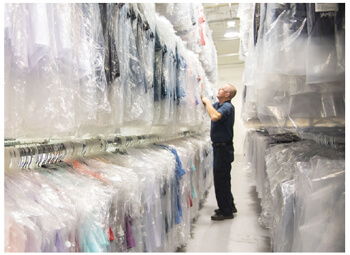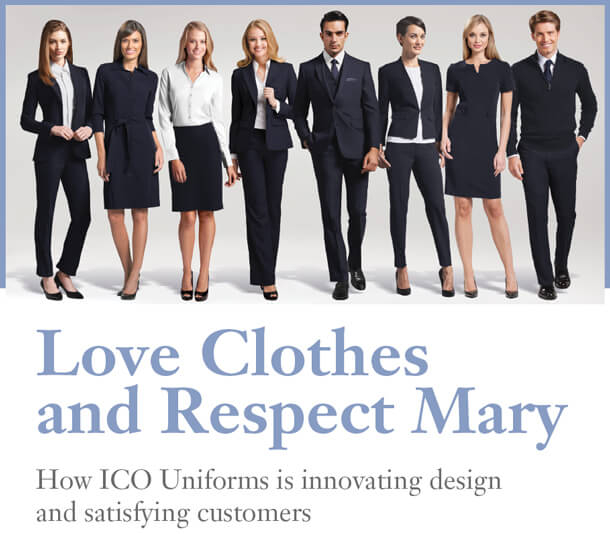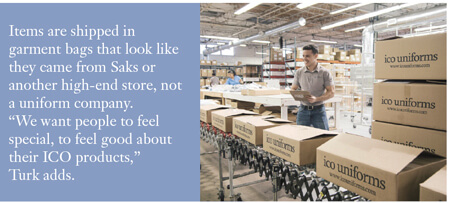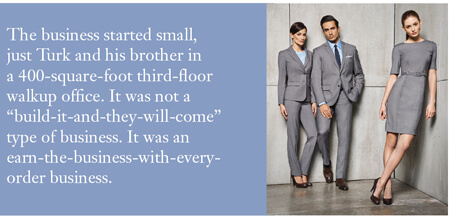By Jackie Rosselli
The ICO difference is evident in the first minutes of conversation with its owner, Jim Turk. Turk considers himself the distributor of “cool clothing” rather than the purveyor of prosaic image apparel programs. A self-described lover of clothes, Turk believes there is something magical about a person leaving the house and liking what they wear and how they look.
“It’s a powerful thing,” he muses.
In an age of never-ending consolidation where the drive for profit and market share can sometimes stifle creativity, ICO takes a different approach.
“This is not a get-rich-quick type of business,” Turk says. “We take a long-term view to any program we’re working on, and we genuinely want the wearer to look and feel great wearing our clothing.”
If the company has a niche – and Turk insists it doesn’t – it would seem to be the hospitality industry, with its emphasis on stylish, more fashion-forward clothing. But its customer list runs the gamut from small, standalone properties to national accounts; most are mid-tier customers with sophisticated program requirements looking for a high level of service.
ICO’s clients tend to have at least one thing in common: they’re looking for something different. “Companies come to us because of our proprietary line. They like the style of our tailored dresses or the cut of our suits,” Turk says. “But if they’re simply looking for the cheapest price on a Red Kap product, they’re typically not going to come to us even though, of course, we sell that too.”
ICO takes a holistic approach to its customer’s apparel needs, focusing on the individual wearer just as much as the corporate decision-maker. The company puts itself squarely in the roles of both personal representative and style consultant to each employee once they are hired by an account.
“When Mary calls to complain about her sweater, Mary is treated as the client. Mary’s request may or may not be reasonable, but she’s still the client and is treated as such. We do what it takes to make Mary happy and feel good about wearing ICO.”
This personalized service extends to its packaging. Every box that ships from ICO leaves looking the same way. Every piece of tape is affixed the same; every shipping label is in the same spot. Items are shipped in garment bags that look like they came from Saks or another high-end store, not a uniform company. “We want people to feel special, to feel good about their ICO products,” Turk adds.
There are other distinctions as well. Turk describes ICO as a “new economy company,” one more in step with millennials than baby-boomers. Its staff of 85 is young, and turnover is low. Many are hired right out of school as entry-level employees and wind up at different job functions years later. Technically, there’s no “corporate ladder” to climb. ICO looks for career-minded, success-driven teammates and works hard to provide flexible employment practices and schedules. “We’re committed to seeing our team members succeed and grow, and that manifests itself in the treatment of staff, vendors and associates,” says Turk. “A happy ICO team member will further our mission and drive customer satisfaction.”
 Not a “Build It and They Will Come” Biz
Not a “Build It and They Will Come” Biz
A desire to stand out from the pack is what gave rise to ICO in the first place. ICO Uniforms’ heritage dates back to 2002 when Turk, who had a lengthy pedigree and successful track record in the hospitality uniform business, teamed up with his brother Scott, a magazine publishing executive, to open a boutique uniform company that would change the way companies and organizations approached the outfitting of their staff.
“I ran a region for the direct sales division of a large public uniform company and saw an opportunity to do things a little bit differently,” Turk says. Styles were historically dated during this period he believes, especially when it came to tailored clothing. Industry consolidation was in full swing, leaving many end users to feel as if they were little fish in a big pond from a service perspective. “I wanted to do something a little different, with a greater emphasis on fashion and a strong customer-centric focus.”
The business started small, just Turk and his brother in a 400-square-foot third-floor walkup office. It was not a “build-it-and-they-will-come” type of business. It was an earn-the-business-with-every-order business. With an emphasis on the hospitality sector, ICO grew one department at a time. One hotel turned into a collection of hotels; one business turned into a portfolio of corporate clients.
Today, ICO is housed in two buildings that total 60,000 square feet: one a distribution center that includes its production team, finishing goods and warehouse operations; the other holds sales, accounting, customer service and design and creative staff, as well as an in-house photo studio to shoot ICO’s constantly evolving proprietary line. Products ship throughout the United States and the Caribbean.
The apparel is embellished in a variety of ways. An in-house sewing operation provides some alterations but can also turn pants into capris or cut long sleeves into short. About 25,000 pieces a month are embroidered at an outside facility in which ICO has ownership but operates as a standalone business. Silk screening is contracted out as necessary.
Much of its new business is driven through referrals. Turk says that the hospitality industry is fairly fluid; the manager at a Marriott one day can quickly become the VP at another hotel company the next. “If they’ve had a positive experience, they take us with them.”
ICO doesn’t have a storefront; it sells business-to-business to the end user. The Miami-based company had sales approaching $20 million in 2015.
As much as things have changed in the uniform industry since Turk worked for a large public uniform company, much has stayed the same. “A lot of the players are still there, doing things the same way,” Turk notes.
Besides its own line, ICO sells products from the likes of Edwards, VF and San Mar to name a few. “Within the vendor line, we have a good ability to select the very best vendors, and we know what is best for our clients from a style perspective, but products from outside vendors are not what distinguishes us.”
What does distinguish ICO is its ICO Brand Collection, a strong design team and great group of stylists and merchandisers who help create programs for clients at the highest levels in their respective industries. Its inventory is like no other. ICO has several million dollars of product on its shelf of finished goods, plus raw materials – numbers unheard of in the uniform or retail market segments. Its turnaround time is equally impressive thanks to a flexible supply chain. The company produces in Asia but also in this hemisphere, according to Turk. “If someone needs 10, 20 or 50 pieces and we have a temporary backorder, we’re able to respond and replenish stock quickly.”
New dresses, blouses and sweaters are added to the collection frequently, giving companies the chance to keep things fresh, and seasonal items are rolled out for certain customers and markets. For example, ICO recently rolled out a woman’s trench coat, loaded with right-off-the-shelf styling. The item will be replaced next year with something different. While atypical for the uniform industry, where continuity reigns supreme, constant updating and forward thinking are major elements of each new piece. Turk says the same objective can be achieved while infusing fashion items to give the program sizzle. He says the unexpected inclusions are appreciated by both the wearer and the client who, in addition to servicing its own clients, is working hard to engage and retain their people.
And because the focus is on fashion, ICO pushes the envelope a bit, manufacturing some of its overseas stock in factories with better skilled workers who are accustomed to producing high-end brands. The result is a finished piece with detailing usually unseen in the uniform industry. “For us, it’s about building a better product. It’s about building products we believe our clients will like to wear, products we like to wear ourselves” he adds.
Online Presence: Important for Credibility
Even when they were a staff of two, ICO worked hard to present a professional image through various platforms, including its website. Their online presence isn’t benchmarked against others in the industry; rather, it is inspired by fashion. From the models used to the way in which a photo is shot, the look and feel says retail, not uniforms. “It’s important to have an image that is consistent with the brand you’re trying to build,” Turk notes.
They’re more engaged on social media than most uniform companies, and they can be found on Instagram, Facebook and LinkedIn. Turk readily admits that customers aren’t necessarily interested in engaging with a uniform company on social media, but from a credibility perspective, it’s important to have a presence.
The same holds true for ecommerce; few customers will buy what they sell without a high level of engagement. ICO hosts online personalized stores for existing customers and to date has close to 400 set up.
 Challenges: Fit and Fast Fashion
Challenges: Fit and Fast Fashion
No business runs smoothly, of course, and ICO has its share of hurdles. The perfect fit can be tricky in any situation but is particularly challenging when selling tailored clothing or suits. ICO’s team of professionals conducts on-site fittings for its customers, and at any given time, there can be two, three or four teams travelling to various parts of the country to assure the apparel fit is as good as its looks. They offer customers a wide range of sizing options as well; ICO cuts from 00 to size 32, a feat unmatched in retail.
Then there’s the challenge of what Turk calls fast fashion. ICO competes against retail in some markets, and it can be difficult to explain the cost differential between a uniform garment that is constructed to last and a blazer that is quickly thrown together and marketed and sold for one season’s worth of use. It’s also hard to explain why it’s unwise for a company to give its employees $400 to buy their own black suit at the mall. “We remind them that, when they need another piece in six months, we’ll have it on the shelf. When a new associate comes onboard, we will be able to dress him or her quickly and consistently. When an associate needs a size 22 and cannot find it in the mall, we’ll have it on the shelf,” Turk says. “Justifying price can be a hard sell when the whole mall is on sale.”
But he’s up for the challenge. “We have an incredible team at ICO, and we are very fired up to continue to grow our business with image-conscious clients who recognize the power of their associates coming to work looking and feeling their best.”
ICO Uniforms
(305) 758-8979
(888) 380-5646
www.icouniforms.com
[email protected]















